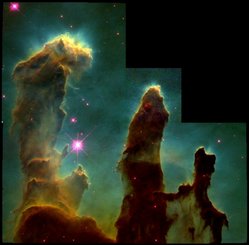HOW THE SOLAR SYSTEM WAS FORMED
Our solar system is part of an entity called our universe. There were many attempts made in the past to explain how our solar system and universe came into existence as we observe it today. Most scientists use the Big Bang Theory, though some people have other theories.
Big Bang Theory
This theory is based around the idea that an enormous explosion occured about 13.7 billion years ago. That is about 13,700,000,000 years ago. This is three times the age of Earth! The Big Bang was not a usual explosion in space because space and time themselves were made in the explosion. This explosion caused the formation of the matter and energy in the universe. At first, the universe was very hot. The planets, stars and all other heavenly bodies formed starting some time after the Big Bang after the universe had cooled down.
The universe had been expanding and cooling since the Big Bang. Most galaxies are moving further away from our Milky Way galaxy. The exceptions are the few galaxies that are close enough to the Milky Way for gravity to overcome the universe's expansion.
Scientists can still see the faint light from when the universe was hot. Over time, the universe's expansion stretched out the light, turning it into weak microwave light. Scientists can detect this microwave light.
Milky Way Galaxy Formation
Solar System Formation
The solar system formed out of a big cloud of gas and dust about 4.6 billion years ago.

Stars and solar systems that are very similar to the Sun are now forming in the Eagle Nebula (also known as M16). While this is not a picture of our own sun, it can give you an idea of what our solar system looked like billions of years ago. These gas clouds that you see in this image were formed from earlier stars that exploded and left stuff behind.
Small finger-like parts of these clouds, especially at the "top" of the first column on the left, are the new stars that are forming. Astronomers who have been watching these stars form have seen changes happen in just a few years, which is a very rapid change for the life of a star.
Solar System
- Table of Contents
- Introduction
- About the Solar System
- The Sun
- Mercury
- Venus
- Earth
- Moon
- Mars
- Asteroid belt
- Jupiter
- Saturn
- Uranus
- Neptune
- Pluto
- Comets
- Kuiper Belt
- Oort Cloud
- How the Solar System was born
- What will happen to the Solar System in the future
- Solar System/Space exploration
- Glossary
Beyond The Solar System
Earth Systems
- Layers of the Earth -- What are the different types of Seismic Waves
- What causes precipitation? What causes it to rain or snow? What causes dew on the ground?
- What is the Coriolis Effect?
- About gravity, mass, and weight
- What are seismic waves? What are the different types of seismic waves?
- What is Humidity? How is Humidity Measured?
- What causes precipitation --( rain or snow)?